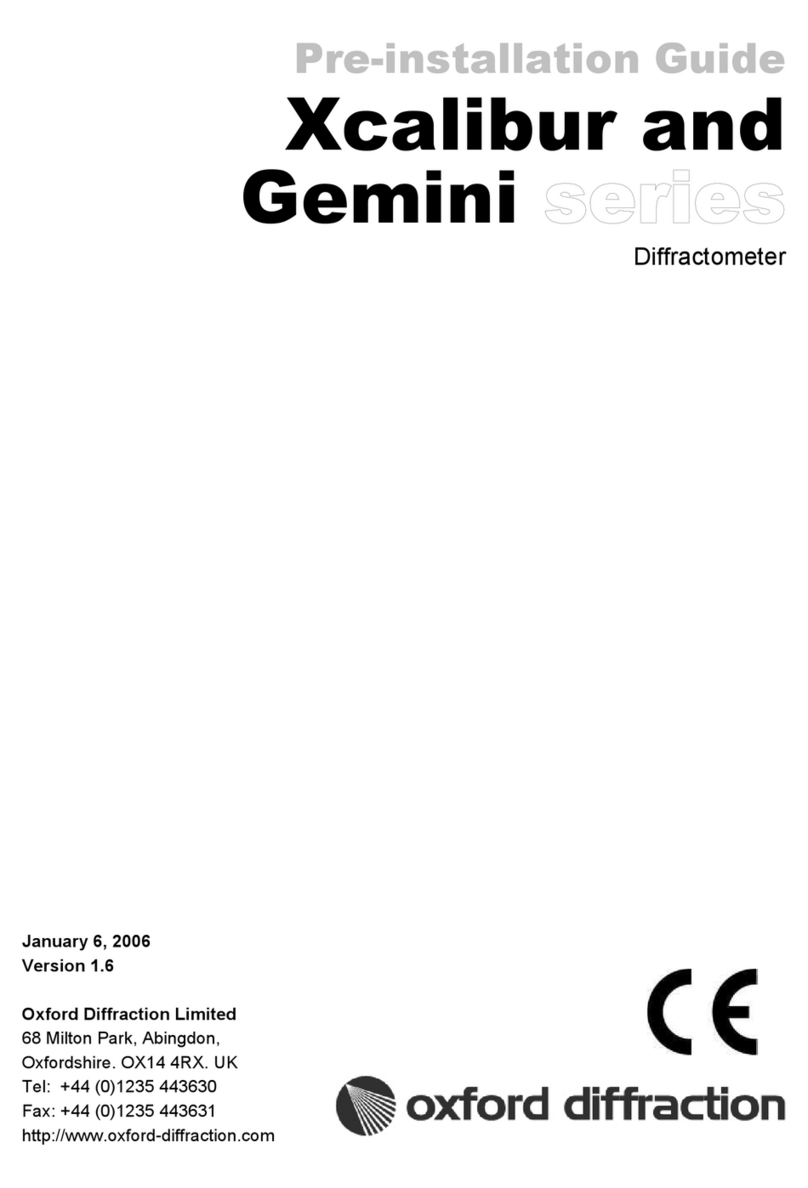
Xcalibur
Xcalibur
A
ENHANCE
Version 1.8
USER MANUAL Page iv
4.2.13. Zingers and Cosmic Ray Events............................................................................... 18
4.3 Four-Circle Kappa Geometry Goniometer ............................................................................ 18
4.4 X-ray Generator..................................................................................................................... 19
4.5 Software ................................................................................................................................ 19
4.6 KMW200CCD Chiller and KMW3000C Chiller...................................................................... 19
4.7 Low Temperature Option....................................................................................................... 19
4.8 Safety Features..................................................................................................................... 19
5. Handling, Installation, Storage and Transit Information............21
5.1 Reception and Handling........................................................................................................ 21
5.1.1. Delivery ....................................................................................................................... 21
5.1.2. Unpacking ................................................................................................................... 21
5.1.3. Mechanical Handling................................................................................................... 22
5.2 Installation and Setting to Work ............................................................................................ 23
5.2.1. Preparation of Site and Services ................................................................................ 23
5.2.2. Setting to Work............................................................................................................ 25
5.3 Storage.................................................................................................................................. 28
6. Operation.......................................................................................29
6.1 Controls and Indicators ......................................................................................................... 29
6.2 System Start-Up.................................................................................................................... 31
6.3 X-ray Tube Warm-up Procedure ........................................................................................... 32
6.4 System Standby and Normal Shutdown Procedure.............................................................. 32
6.5 Emergency Shutdown ........................................................................................................... 33
6.5.1. Emergency Shutdown Procedure ............................................................................... 33
7. Installation of Detectors...............................................................34
7.1 Interchange of Detectors....................................................................................................... 34
8. Maintenance Schedules ...............................................................35
8.1 Introduction............................................................................................................................ 35
8.2 Weekly Maintenance Schedule............................................................................................. 35
8.3 Monthly Maintenance Schedule............................................................................................ 35
8.4 Six Monthly Maintenance Schedule...................................................................................... 36
8.5 Yearly Maintenance Schedule .............................................................................................. 36
8.6 10,000 Hours Maintenance Schedule ................................................................................... 36
9. Maintenance Instructions.............................................................38
9.1 Special Tools......................................................................................................................... 38
9.2 Refining the Machine Parameter File.................................................................................... 39
9.3 Changing the X-ray Tube of Enhance (Vertical X-ray Tubes) .............................................. 39
9.4 Changing the Collimator of Enhance .................................................................................... 40
9.5 Aligning the X-ray Collimator of Enhance ............................................................................. 41
9.6 Aligning the Enhance X-ray Source ...................................................................................... 41
9.7 X-ray Beam Stop Alignment.................................................................................................. 44
9.8 Aligning the Video Microscope.............................................................................................. 47
9.9 Checking the Door Safety Interlocks..................................................................................... 48
9.10 Checking the Emergency stop ............................................................................................ 49
9.11 Checking the X-ray Radiation Levels .................................................................................. 50
9.12 Onyx, Ruby, Atlas and Titan CCD Detector – Pumping Out Vacuum ................................ 50
9.13 Dismantling the Diffractometer............................................................................................ 52






























